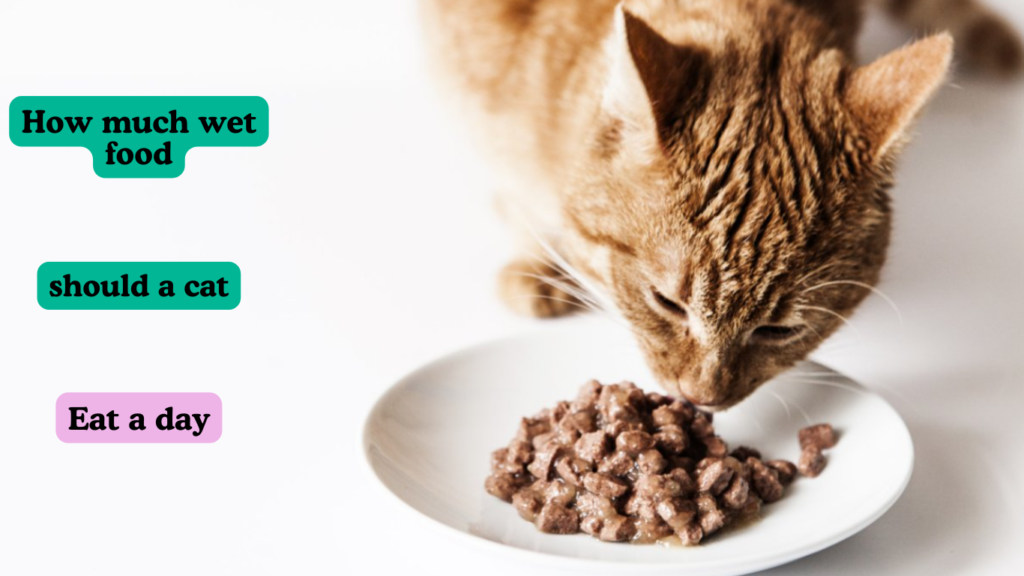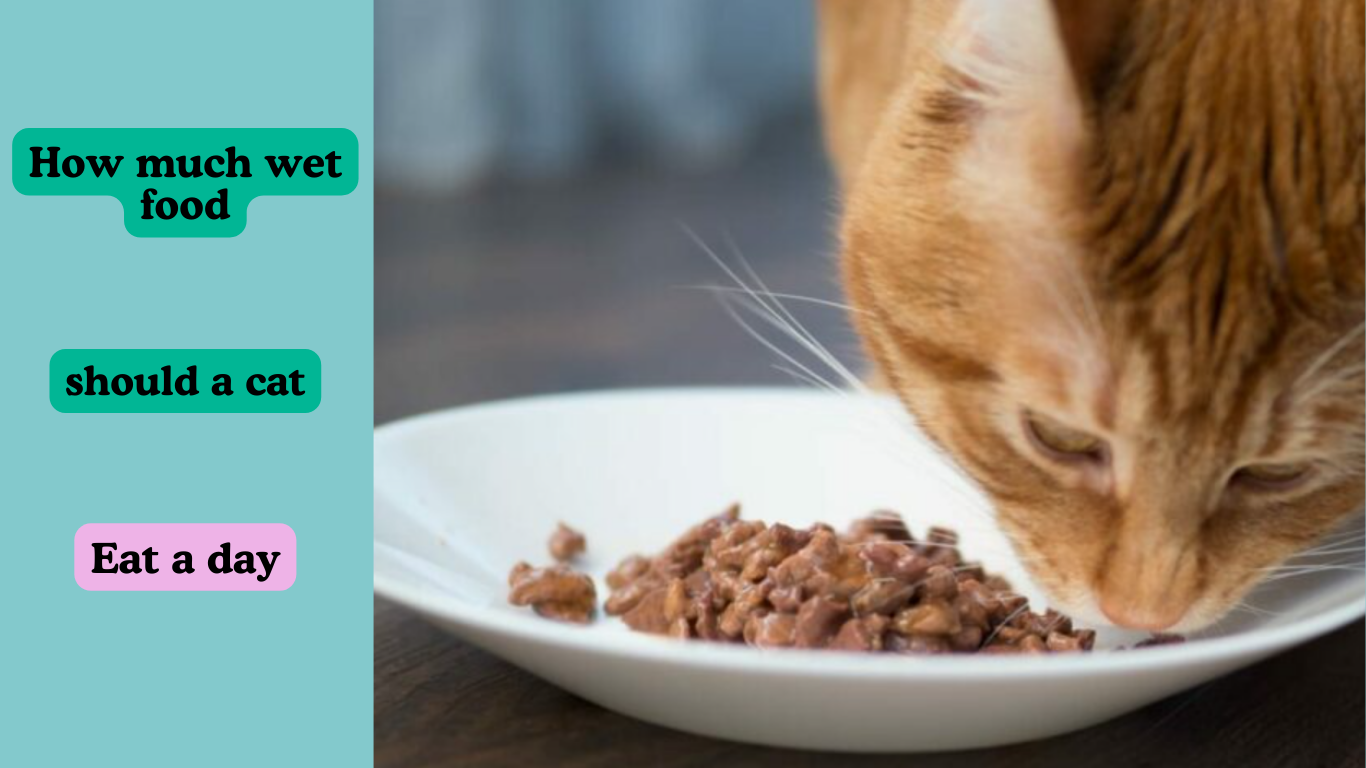Introduction
Cats are beloved pets for many people, and as responsible cat owners, it’s essential to ensure that they are receiving the appropriate nutrition. One of the key considerations is how much wet food should a Cat eat a day.
In this article, we will explore the importance of wet food for cats, factors to consider when determining the ideal amount of wet food, and how to transition a cat to a wet food diet.
Table of Contents
How Much Wet Food Should a Cat Eat a Day
Why is Wet Food Important for Cats
It’s important to note that a specific number can vary depending on factors like the cat’s weight, age, and activity level, as well as the nutritional content of the particular wet cat food you are using. As a very rough estimate, a typical adult cat might consume about 3 to 5 ounces (85 to 142 grams) of wet food per meal, and meals are often twice a day.
Wet food is a crucial component of a cat’s diet and offers numerous benefits for their overall health and well-being. In this section, we will delve deeper into the reasons why wet food is essential for cats.
Dehdration in Cats
Cats are notorious for not drinking enough water, which can lead to dehydration and other health issues. Wet food contains a high moisture content, typically around 70-80%, which helps to keep cats hydrated. This is especially important for cats who may not have access to fresh water throughout the day or those who are prone to urinary tract problems.
Additionally, wet food can be a great option for cats who are recovering from an illness or surgery, as it helps to keep them hydrated and provides necessary nutrients for their recovery.
Cats are Carnivores
Cats are obligate carnivores, meaning they require a diet high in protein and low in carbohydrates. Wet food is typically made with high-quality animal protein sources, such as chicken, fish, or beef, making it an ideal choice for meeting a cat’s natural dietary needs.
Furthermore, wet food is less processed than dry food, which means it retains more of its natural nutrients and is easier for cats to digest. This can lead to better overall health and a reduced risk of obesity and other health issues.
Some cats can be picky eaters and may turn their noses up at dry food. Wet food offers a different texture and flavor, which can entice even the pickiest of eaters. This is especially beneficial for cats who may have lost their appetite due to illness or old age.
Additionally, wet food can be a great option for cats who have dental issues or are missing teeth, as it is easier for them to chew and digest. Below are somne of the key points that needs to be noted in order to feed your cat wet food:
- Wet food provides essential hydration for cats, especially those who may not drink enough water throughout the day.
- It has a high protein content and low carbohydrate levels, which aligns with a cat’s natural dietary requirements.
- The texture and flavor of wet food can entice picky eaters and encourage them to consume necessary nutrients.
- Wet food is less processed than dry food, retaining more natural nutrients and aiding in digestion.
- It can be a great option for cats with dental issues or those who have lost their appetite due to illness or old age.
Wet food is an important part of a cat’s diet and offers numerous benefits for their health and well-being. It provides essential hydration, meets their natural dietary requirements, and appeals to picky eaters. Consider incorporating wet food into your cat’s diet to ensure they are getting all the necessary nutrients for a happy and healthy life.

Factors to Consider
When determining the appropriate amount of wet food for a cat, there are several important factors to take into consideration. These include the cat’s age, weight, activity level, overall health, and any specific dietary requirements or restrictions. By carefully considering these factors, you can ensure that your cat is receiving the proper amount of wet food to maintain a healthy and balanced diet.
Age of a Cat
The age of your cat is an important factor to consider when determining their daily wet food intake. Kittens, for example, require more food than adult cats due to their rapid growth and high energy levels. As a general rule, kittens should be fed three times a day until they are six months old, then twice a day until they reach one year of age. Adult cats, on the other hand, typically only need to be fed once or twice a day.
Weight of a Cat
The weight of your cat is another crucial factor to consider when determining their wet food intake. Overweight cats may need to have their food intake reduced, while underweight cats may require more food. It is important to regularly monitor your cat’s weight and adjust their food intake accordingly to maintain a healthy weight.
The activity level of your cat can also impact their daily wet food intake. Cats who are more active and playful will require more food to fuel their energy levels, while less active cats may need less food. It is important to take your cat’s activity level into consideration when determining their food intake to ensure they are receiving enough nutrients to support their lifestyle.
Health of a Cat
The overall health of your cat is another important factor to consider when determining their wet food intake. Cats with certain health conditions, such as diabetes or kidney disease, may require a special diet and specific feeding schedule. It is important to consult with your veterinarian to determine the best wet food and feeding plan for your cat’s specific health needs.
- Age, weight, activity level, overall health, and dietary requirements should all be taken into consideration when determining a cat’s wet food intake.
- Kittens require more food than adult cats due to their rapid growth and high energy levels.
- Overweight cats may need to have their food intake reduced, while underweight cats may require more food.
- The activity level of a cat can impact their food intake, with more active cats needing more food to fuel their energy levels.
- Cats with certain health conditions may require a special diet and specific feeding schedule.
- Some cats may have specific dietary requirements or restrictions that need to be considered when choosing wet food.
- The nutritional content of wet food, including protein, fat, and carbohydrates, should be carefully evaluated to ensure a balanced diet for cats.
The Ideal Amount of Wet Food
When it comes to feeding your cat, it’s important to find the right balance of nutrients and portion sizes. Wet food is a popular choice among cat owners due to its high moisture content and palatability. However, determining the ideal amount of wet food to feed your cat can be a bit tricky. Here are some factors to consider and guidelines to follow.
- Age: Kittens and senior cats may have different caloric needs compared to adult cats.
- Activity level: An active cat may require more calories than a sedentary cat.
- Body weight: A larger cat may need more food compared to a smaller cat.
- Health conditions: Cats with certain health conditions may require a special diet or portion control.
- Brand and type of wet food: Different brands and types of wet food may have varying caloric content, so it’s important to check the label for feeding guidelines.
As a general guideline, an adult cat typically requires approximately 24 to 35 calories per pound of body weight per day. However, this can vary depending on the factors mentioned above. It’s important to consult with a veterinarian to determine the specific caloric needs of your cat and adjust the portion sizes accordingly.
Cats with Special Dietary Needs
Cats with special dietary needs require customized feeding plans to ensure their unique nutritional requirements are met. These needs may arise due to medical conditions such as kidney disease or diabetes. It is important to consult with a veterinarian to develop a suitable feeding plan for your cat.
Here are some factors to consider when creating a specialized diet for your cat:
- Medical condition: The first step in creating a specialized diet for your cat is to identify their medical condition and understand how it affects their nutritional needs. This will help you determine the appropriate type and amount of food to feed your cat.
- Dietary restrictions: Some medical conditions may require your cat to avoid certain ingredients or nutrients. For example, cats with kidney disease may need to limit their protein intake, while diabetic cats may need a diet low in carbohydrates.
- Age and weight: The age and weight of your cat can also play a role in their dietary needs. Kittens and senior cats may have different nutritional requirements compared to adult cats. Additionally, overweight or underweight cats may require a specialized diet to help them reach a healthy weight.
- Food preferences: It is important to consider your cat’s food preferences when creating a specialized diet. If your cat does not like the taste or texture of their food, they may not eat enough to meet their nutritional needs.
Based on these factors, your veterinarian may recommend a specialized wet food formula for your cat. Wet food is often preferred for cats with special dietary needs because it is easier to control the ingredients and nutrient levels compared to dry food. Additionally, wet food has a higher moisture content, which can be beneficial for cats with certain medical conditions.
Transitioning to Wet Food
Transitioning a cat to a wet food diet should be done gradually to prevent digestive upset. While dry food may be convenient, wet food offers numerous benefits for cats and should be incorporated into their diet. Here are some tips for successfully transitioning your cat to a wet food diet:
- Start Slow: It’s important to introduce wet food slowly to avoid any digestive issues. Begin by mixing a small amount of wet food into your cat’s existing diet and gradually increase the proportion over time. This will allow your cat to become accustomed to the new food while maintaining balanced nutrition.
- Consider Texture: Cats can be picky eaters, so it’s important to consider the texture of the wet food you choose. Some cats may prefer pate-style wet food, while others may prefer chunks or shreds. Experiment with different textures to find what your cat enjoys.
- Flavor Matters: Just like humans, cats have their own preferences when it comes to food. When transitioning to wet food, it’s important to choose flavors that your cat enjoys. This will make the transition smoother and increase the chances of your cat accepting the new diet.
- Gradually Increase Proportion: As your cat becomes more accustomed to wet food, gradually increase the proportion of wet food in their diet. This can take anywhere from a few days to a few weeks, depending on your cat’s individual preferences.
- Monitor for Digestive Issues: Keep an eye on your cat’s digestion during the transition period. If you notice any vomiting, diarrhea, or other digestive issues, slow down the transition and consult with your veterinarian.
Conclusion
Determining the appropriate amount of wet food for a cat requires careful consideration of various factors, including the cat’s individual needs, dietary requirements, and health status.
By understanding the significance of wet food in a cat’s diet, cat owners can make informed decisions to ensure their feline companions receive the nutrition they need to thrive. As with any aspect of a cat’s care, consulting with a veterinarian is essential to tailor feeding guidelines to the specific needs of the cat.

